Demographic Analysis of Occupational Safety in the Construction Sector: Strategies and Insights for Risk Reduction
Abstract
:1. Introduction
Literature Review
2. Materials and Methods
3. Results and Discussion
3.1. Analysis of Workers in the Construction Sector
3.1.1. Impact of Gender in Construction Sector
- Worker Profile
- Workforce Profile Affected by Occupational Accidents
3.1.2. Impact of Marital Status in Construction Sector
- Worker Profile
- Workforce Profile Affected by Occupational Accidents
3.1.3. Effect of Age in the Construction Sector
- Worker Profile
- Workforce Profile Affected by Occupational Accidents
3.1.4. Impact of Work Experience in the Construction Sector
- Worker Profile
- Workforce Profile Affected by Occupational Accidents
3.2. Analyses of Workers Affected by Occupational Accidents in Construction Industry
3.2.1. Analysis of Incapacity for Work Status with Logistic Regression
3.2.2. Demographic Differences in Lost Workdays
4. Conclusions
Funding
Data Availability Statement
Acknowledgments
Conflicts of Interest
References
- Lopes, J.; Banaitienė, N. A model for construction sector development in middle-income sub-Saharan African countries. Technol. Econ. Dev. Econ. 2024, 30, 1229–1255. [Google Scholar] [CrossRef]
- Alaloul, W.S.; Musarat, M.A.; Rabbani, M.B.A.; Iqbal, Q.; Maqsoom, A.; Farooq, W. Construction sector contribution to economic stability: Malaysian GDP distribution. Sustainability 2021, 13, 5012. [Google Scholar] [CrossRef]
- Brucker Juricic, B.; Galic, M.; Marenjak, S. Review of the Construction Labour Demand and Shortages in the EU. Buildings 2021, 11, 17. [Google Scholar] [CrossRef]
- Başağa, H.B.; Temel, B.A.; Atasoy, M.; Yıldırım, İ. A study on the effectiveness of occupational health and safety trainings of construction workers in Turkey. Saf. Sci. 2018, 110, 344–354. [Google Scholar] [CrossRef]
- Kaluthantirige, P.; Silva, L.; Hewage, K.; Kaur Gil, S.P.; Gill, A. Construction labor shortage, challenges, and solutions: A survey-based approach. In Proceedings of the Twelfth International Structural Engineering and Construction Conference, Chicago, IL, USA, 14–18 August 2023; p. 10. [Google Scholar] [CrossRef]
- Trillo-Cabello, A.F.; Carrillo-Castrillo, J.A.; Rubio-Romero, J.C. Perception of risk in construction. Exploring the factors that influence experts in occupational health and safety. Saf. Sci. 2021, 133, 104990. [Google Scholar] [CrossRef]
- Bilim, A.; Çelik, O.N. Türkiye’deki İnşaat Sektöründe Meydana Gelen İş Kazalarının Genel Değerlendirmesi. Ömer Halisdemir Üniversitesi Mühendislik Bilim. Derg. 2018, 7, 725–731. [Google Scholar] [CrossRef]
- Fung, I.W.H.; Tam, V.W.Y. Occupational Health and Safety of Older Construction Workers (Aged 55 or Above): Their Difficulties, Needs, Behaviour and Suitability. Int. J. Constr. Manag. 2013, 13, 15–34. [Google Scholar] [CrossRef]
- Poh, C.Q.X.; Ubeynarayana, C.U.; Goh, Y.M. Safety leading indicators for construction sites: A machine learning approach. Autom. Constr. 2018, 93, 375–386. [Google Scholar] [CrossRef]
- Martínez-Rojas, M.; Martín Antolín, R.; Salguero-Caparrós, F.; Rubio-Romero, J.C. Management of construction Safety and Health Plans based on automated content analysis. Autom. Constr. 2020, 120, 103362. [Google Scholar] [CrossRef]
- Dong, X.; Ringen, K.; Men, Y.; Fujimoto, A. Medical costs and sources of payment for work-related injuries among hispanic construction workers. J. Occup. Environ. Med. 2007, 49, 1367–1375. [Google Scholar] [CrossRef] [PubMed]
- Chiang, Y.-H.; Wong, F.K.-W.; Liang, S. Fatal Construction Accidents in Hong Kong. J. Constr. Eng. Manag. 2018, 144, 04017121. [Google Scholar] [CrossRef]
- Martínez-Rojas, M.; Marín, N.; Vila, M.A. A Preliminary Approach to Classify Work Descriptions in Construction Projects. In Proceedings of the 2013 Joint IFSA World Congress and NAFIPS Annual Meeting, IFSA/NAFIPS, Edmonton, AB, Canada, 24–28 June 2013; Volume 2013, pp. 1090–1095. [Google Scholar] [CrossRef]
- Ho, J.J.; Hwang, J.S.; Wang, J.D. Estimation of reduced life expectancy from serious occupational injuries in Taiwan. Accid. Anal. Prev. 2006, 38, 961–968. [Google Scholar] [CrossRef] [PubMed]
- Castillo-Rosa, J.; Suárez-Cebador, M.; Rubio-Romero, J.C.; Aguado, J.A. Personal factors and consequences of electrical occupational accidents in the primary, secondary and tertiary sectors. Saf. Sci. 2017, 91, 286–297. [Google Scholar] [CrossRef]
- Choi, J.; Gu, B.; Chin, S.; Lee, J.S. Machine learning predictive model based on national data for fatal accidents of construction workers. Autom. Constr. 2020, 110, 102974. [Google Scholar] [CrossRef]
- Debela, M.B.; Azage, M.; Begosaw, A.M.; Kabeta, N.D. Factors contributing to occupational injuries among workers in the construction, manufacturing, and mining industries in Africa: A systematic review and meta-analysis. J. Public. Health Policy 2022, 43, 487–502. [Google Scholar] [CrossRef] [PubMed]
- Szóstak, M. The application of cluster analysis to identify the occupational profile of people injured in accidents in the Polish construction industry. In Proceedings of the IOP Conference Series: Materials Science and Engineering, Novosibirsk, Russian Federation, 1–8 July 2018; Volume 456, p. 012027. [Google Scholar] [CrossRef]
- Lingard, H.; Rowlinson, S. Occupational Health and Safety in Construction Project Management; Routledge: Osfordshire, UK, 2004. [Google Scholar]
- Chi, S.; Han, S.; Kim, D.Y. Relationship between unsafe working conditions and workers’ behavior and impact of working conditions on injury severity in US construction industry. J. Constr. Eng. Manag. 2013, 139, 826–838. [Google Scholar] [CrossRef]
- Hasan, A.; Kamardeen, I. Occupational health and safety barriers for gender diversity in the Australian construction industry. J. Constr. Eng. Manag. 2022, 148, 04022100. [Google Scholar] [CrossRef]
- Oo, B.L.; Lim, B.T.H. Women Workforces’ Satisfaction with Personal Protective Equipment: A Case of the Australian Construction Industry. Buildings 2023, 13, 959. [Google Scholar] [CrossRef]
- Tam, C.M.; Zeng, S.X.; Deng, Z.M. Identifying elements of poor construction safety management in China. Saf. Sci. 2004, 42, 569–586. [Google Scholar] [CrossRef]
- Bahrami, A.; Akbari, H.; Zamani-Badi, H. Relationship between some personal and occupational factors and accident in workers of metal industry. Int. Arch. Health Sci. 2019, 6, 131. [Google Scholar] [CrossRef]
- Bilim, N.; Bilim, A. Estimation of the risk of work-related accidents for underground hard coal mine workers by logistic regression. Int. J. Occup. Saf. Ergon. 2022, 28, 2362–2369. [Google Scholar] [CrossRef]
- Bravo, G.; Castellucci, H.I.; Lavallière, M.; Arezes, P.M.; Martínez, M.; Duarte, G. The influence of age on fatal work accidents and lost days in Chile between 2015 and 2019. Saf. Sci. 2022, 147, 105599. [Google Scholar] [CrossRef]
- Gebremichael, G.; Kumie, A.; Ajema, D. The Prevalence and Associated Factors of Occupational Injury among Workers in Arba Minch Textile Factory, Southern Ethiopia: A Cross Sectional Study. Occup. Med. Health Aff. 2015, 3, 6. [Google Scholar] [CrossRef]
- Sanmiquel, L.; Rossell, J.M.; Vintró, C. Study of Spanish mining accidents using data mining techniques. Saf. Sci. 2015, 75, 49–55. [Google Scholar] [CrossRef]
- Berglund, L.; Johansson, M.; Nygren, M.; Samuelson, B.; Stenberg, M.; Johansson, J. Occupational accidents in Swedish construction trades. Int. J. Occup. Saf. Ergon. 2021, 27, 552–561. [Google Scholar] [CrossRef]
- Bilim, A.; Çelik, O.N. Estimating the possibility of workday loss accidents in road construction. Gradjevinar 2023, 75, 1183–1192. [Google Scholar] [CrossRef]
- Chau, N.; Mur, J.M.; Benamghar, L.; Siegfried, C.; Dangelzer, J.L.; Francais, M.; Jacquin, R.; Sourdot, A. Relationships between Some Individual Characteristics and Occupational Accidents in the Construction Industry: A Case-Control Study on 880 Victims of Accidents Occurred during a Two-Year Period. J. Occup. Health 2002, 44, 131–139. [Google Scholar] [CrossRef]
- Chi, C.F.; Yang, C.C.; Chen, Z.L. In-depth accident analysis of electrical fatalities in the construction industry. Int. J. Ind. Ergon. 2009, 39, 635–644. [Google Scholar] [CrossRef]
- Colak, B.; Etiler, N.; Bicer, U. Fatal Occupational Injuries in the Construction Sector in Kocaeli, Turkey, 1990–2001. Ind. Health 2004, 42, 424–430. [Google Scholar] [CrossRef]
- Hoła, B.; Szóstak, M. An Occupational Profile of People Injured in Accidents at Work in the Polish Construction Industry. Procedia Eng. 2017, 208, 43–51. [Google Scholar] [CrossRef]
- Winge, S.; Albrechtsen, E.; Mostue, B.A. Causal factors and connections in construction accidents. Saf. Sci. 2019, 112, 130–141. [Google Scholar] [CrossRef]
- Dumrak, J.; Mostafa, S.; Kamardeen, I.; Rameezdeen, R. Factors Associated with the Severity of Construction Accidents: The Case of South Australia. Australas. J. Constr. Econ. Build. 2013, 13, 32–49. [Google Scholar] [CrossRef]
- Kamardeen, I.; Rameezdeen, R. Modelling Accident Severity in the Construction Industry. In Proceedings of the 32nd CIB W78 Conference 2015, Eindhoven, The Netherlands, 27–29 October 2015. [Google Scholar]
- Soltanzadeh, A.; Mohammadfam, I.; Moghimbeigi, A.; Ghiasvand, R. Key factors contributing to accident severity rate in construction industry in Iran: A regression modelling approach. Arh. Za Hig. Rada I Toksikol. 2016, 67, 47–53. [Google Scholar] [CrossRef] [PubMed]
- Tetik, Y.O.; Kale, O.A.; Bayram, I.; Baradan, S. Applying decision tree algorithm to explore occupational injuries in the Turkish construction industry. J. Eng. Res. 2022, 10, 59–70. [Google Scholar] [CrossRef]
- Biabani, A.; Zokaie, M.; Falahati, M.; Ziamanesh, S. Investigating Some Individual Factors Effect on the Consequence Severity of Occupational Accidents. Int. J. Occupatıonal Hygıene 2008, 12, 50–59. [Google Scholar]
- He, C.; Hu, Z.; Shen, Y.; Wu, C. Effects of Demographic Characteristics on Safety Climate and Construction Worker Safety Behavior. Sustainability 2023, 15, 10985. [Google Scholar] [CrossRef]
- He, C.; Jia, G.; McCabe, B.; Chen, Y.; Zhang, P.; Sun, J. Psychological decision-making process of construction worker safety behavior: An agent-based simulation approach. Int. J. Occup. Saf. Ergon. 2023, 29, 141–153. [Google Scholar] [CrossRef]
- Arifuddin, R.; Suraji, A.; Latief, Y. Study of the causal factors of construction projects vulnerability to accidents. Int. J. Innov. Technol. Explor. Eng. 2019, 8, 711–716. [Google Scholar]
- Choudhry, R.M. Behavior-based safety on construction sites: A case study. Accid. Anal. Prev. 2014, 70, 14–23. [Google Scholar] [CrossRef] [PubMed]
- Fang, D.; Zhao, C.; Zhang, M. A Cognitive Model of Construction Workers’ Unsafe Behaviors. J. Constr. Eng. Manag. 2016, 142, 04016039. [Google Scholar] [CrossRef]
- Kale, Ö.A. Determınatıon Of Poor Complıance Wıth Osh Rules Of Constructıon Workers Usıng Ordınal Regressıon Model. Mugla J. Sci. Technol. 2020, 6, 78–88. [Google Scholar] [CrossRef]
- Ibrahim, A.; Nnaji, C.; Shakouri, M. Influence of Sociodemographic Factors on Construction Fieldworkers’ Safety Risk Assessments. Sustainability 2021, 14, 111. [Google Scholar] [CrossRef]
- Han, Y.; Jin, R.; Wood, H.; Yang, T. Investigation of Demographic Factors in Construction Employees’ Safety Perceptions. KSCE J. Civ. Eng. 2019, 23, 2815–2828. [Google Scholar] [CrossRef]
- Sakinah, Z.; Suwandi, T.; Soedirham, O. Relationship Analysis between Work Factor and Commitment of Individual with the Occurrence of Unsafe Act (Study in Division of General Engineering PT. XYZ Surabaya). Civ. Environ. Res. 2015, 7. [Google Scholar]
- Siu, O.L.; Phillips, D.R.; Leung, T.W. Age differences in safety attitudes and safety performance in Hong Kong construction workers. J. Saf. Res. 2003, 34, 199–205. [Google Scholar] [CrossRef] [PubMed]
- Khodabandeh, F.; Kabir-Mokamelkhah, E.; Kahani, M. Factors associated with the severity of fatal accidents in construction workers. Med. J. Islam. Repub. Iran 2016, 30, 469. [Google Scholar]
- Koc, K.; Ekmekcioğlu, Ö.; Gurgun, A.P. Developing a National Data-Driven Construction Safety Management Framework with Interpretable Fatal Accident Prediction. J. Constr. Eng. Manag. 2023, 149, 04023010. [Google Scholar] [CrossRef]
- Hatami, S.E.; Ravandi, M.R.G.; Hatami, S.T.; Khanjani, N. Epidemiology of work-related injuries among insured construction workers in Iran. Electron. Physician 2017, 9, 5841. [Google Scholar] [CrossRef]
- Alizadeh, S.S.; Mortazavi, S.B.; Sepehri, M.M. Assessment of accident severity in the construction industry using the Bayesian theorem. Int. J. Occup. Saf. Ergon. 2015, 21, 551–557. [Google Scholar] [CrossRef] [PubMed]
- Villanueva, V.; Garcia, A.M. Individual and occupational factors related to fatal occupational injuries: A case-control study. Accid. Anal. Prev. 2011, 43, 123–127. [Google Scholar] [CrossRef]
- Meng, X.; Chan, A.H.S. Demographic influences on safety consciousness and safety citizenship behavior of construction workers. Saf. Sci. 2020, 129, 104835. [Google Scholar] [CrossRef]
- Park, I.S.; Kim, J.; Han, S.; Hyun, C. Analysis of fatal accidents and their causes in the Korean construction industry. Sustainability 2020, 12, 3120. [Google Scholar] [CrossRef]
- Turkish Contractors Association. Turkish International Contracting Services Report (1972–2023). 2024. Available online: https://www.tmb.org.tr/tr/pubs/60658a294e2c483e72ff8fa7/ydmh-raporu-2024 (accessed on 28 December 2024).
- SSI, Sosyal Güvenlik Kurumu. 2024. Available online: https://www.sgk.gov.tr/Istatistik/Yillik/fcd5e59b-6af9-4d90-a451-ee7500eb1cb4/ (accessed on 1 October 2024).
- Kale, Ö.A.; Baradan, S. Identifying Factors that Contribute to Severity of Construction Injuries using Logistic Regression Model. Tek. Dergi 2020, 31, 9919–9940. [Google Scholar] [CrossRef]
- Bilir, S.; Gürcanlı, G.E. A Method for Determination of Accident Probability in Construction Industry. Tek. Dergi 2018, 29, 8537–8561. [Google Scholar] [CrossRef]
- Kamalvandi, M.; Mohammadfam, I.; Farhadi, R.; Jalilian, M.; Kurd, N. Evaluation of work-related accidents among Hamadan construction workers. J. Basic. Res. Med. Sci. 2017, 4, 44–49. [Google Scholar] [CrossRef]
- Gürcanli, G.E.; Müngen, U. Analysis of construction accidents in Turkey and responsible parties. Ind. Health 2013, 51, 581–595. [Google Scholar] [CrossRef]
- Umar, T.; Egbu, C. Causes of construction accidents in Oman. Middle East. J. Manag. 2018, 5, 21–33. [Google Scholar] [CrossRef]
- Hosseini, M.R.; Maghrebi, M.; Rameezdeen, R.; Waller, S.T. Statistically reviewing construction accidents within South Australia during 2002–2013. In Proceedings of the International Symposium on Automation and Robotics in Construction, Oulu, Finland, 15–18 June 2015; Volume 32, p. 1. [Google Scholar]
- Mohammadfam, I.; Soltanzadeh, A.H.M.A.D.; Moghimbeigi, A.; Akbarzadeh, M. Factors affecting occupational accidents in the construction industry (2009–2013). Occup. Heal. Epidemiology 2014, 3, 88–95. [Google Scholar] [CrossRef]
- Tözer, K.D.; Çelik, T.; Gürcanlı, G.E. Classification of construction accidents in northern Cyprus. Tek. Dergi 2018, 29, 8295–8316. [Google Scholar] [CrossRef]
- Yılmaz, G.K.; Başağa, H.B. Assessment of occupational accidents in construction sector: A case study in Turkey. J. Constr. Eng. Manag. Innov. 2018, 1, 95–107. [Google Scholar]
- Yoon, Y.G.; Ahn, C.R.; Yum, S.G.; Oh, T.K. Establishment of safety management measures for major construction workers through the association rule mining analysis of the data on construction accidents in Korea. Buildings 2024, 14, 998. [Google Scholar] [CrossRef]
- Chen, N.; Zhang, Z.; Yao, X.; Chen, A. Cause analysis of construction safety accidents in China using association rules. Intell. Decis. Technol. 2022, 16, 601–614. [Google Scholar] [CrossRef]
- Birhane, G.E.; Yang, L.; Geng, J.; Zhu, J. Causes of construction injuries: A review. Int. J. Occup. Saf. Ergon. 2022, 28, 343–353. [Google Scholar] [CrossRef] [PubMed]
- Karimi, H.; Taghaddos, H. The influence of craft workers’ educational attainment and experience level in fatal injuries prevention in construction projects. Saf. Sci. 2019, 117, 417–427. [Google Scholar] [CrossRef]
- Lander, F.; Nielsen, K.J.; Lauritsen, J. Work injury trends during the last three decades in the construction industry. Saf. Sci. 2016, 85, 60–66. [Google Scholar] [CrossRef]
- Amiri, M.; Ardeshir, A.; Fazel Zarandi, M.H.; Soltanaghaei, E. Pattern extraction for high-risk accidents in the construction industry: A data-mining approach. Int. J. Inj. Control Saf. Promot. 2016, 23, 264–276. [Google Scholar] [CrossRef] [PubMed]
- Damayanti, F.; Djakfar, L.; Wisnumurti, W.; Nugroho, A.M. Analysis of the Effect of Employee Status on Construction Worker's Safety Behavior Using Structural Equation Model. East. Eur. J. Enterp. Technol. 2022, 6, 120. [Google Scholar] [CrossRef]
- Meng, X.; Chan, A.H. Cross-regional research in demographic impact on safety consciousness and safety citizenship behavior of construction workers: A comparative study between mainland China and Hong Kong. Int. J. Environ. Res. Public. Health 2022, 19, 12799. [Google Scholar] [CrossRef]
- Man, S.S.; Chan, A.H.S.; Alabdulkarim, S.; Zhang, T. The effect of personal and organizational factors on the risk-taking behavior of Hong Kong construction workers. Saf. Sci. 2021, 136, 105155. [Google Scholar] [CrossRef]
- Makori, G.O.; Mamati, E.G.; Njoroge, J.B. Evaluation of Factors that Contribute to Occurrence of Accidents at Construction Sites in Nairobi County. Sci. Res. J. 2018, 6, 1–11. [Google Scholar]
- Osei-Asibey, D.; Ayarkwa, J.; Acheampong, A.; Adinyira, E.; Amoah, P. An examination of causes of accidents and hazards in the Ghanaian construction industry. Open J. Saf. Sci. Technol. 2021, 11, 66–88. [Google Scholar] [CrossRef]
- Sukadarin, E.H.; Zakaria, J. Causes of Accidents in Construction Industries during Covid-19. Curr. Sci. Technol. 2022, 2, 59–66. [Google Scholar] [CrossRef]
- Ahmed, S. Causes of accident at construction sites in Bangladesh. Organ. Technol. Manag. Constr. Int. J. 2019, 11, 1933–1951. [Google Scholar] [CrossRef]
- Abukhashabah, E.; Summan, A.; Balkhyour, M. Occupational accidents and injuries in construction industry in Jeddah city. Saudi J. Biol. Sci. 2020, 27, 1993–1998. [Google Scholar] [CrossRef] [PubMed]
- Bilim, A.; Çelik, O.N. Estimation of Fatal Risks of Road Construction Workers in Occupational Accidents. Karaelmas J. Occup. Health Saf. 2021, 5, 89–98. [Google Scholar] [CrossRef]
- Rutherford, N.N.S.; Daniel, E.I. A systematic review of the barriers and attraction strategies for females in construction. Proc. Inst. Civ. Eng. Manag. Procure. Law 2024, 40, 1–11. [Google Scholar] [CrossRef]
- Rodrigo, N.; Wijewickrama, M.K.C.S.; Rajenthiran, N.; Jayathilaka, W.; Chang, R. Challenges and Solutions for Women in Construction Industry Related Disciplines: A Literature Review. In Proceedings the 12th World Construction Symposium; University of Moratuwa: Moratuwa, Sri Lanka, 2024; p. 331. [Google Scholar]
- Holdsworth, S.; Turner, M.; Sandri, O. Gender Bias in the Australian Construction Industry: Women’s Experience in Trades and Semi-Skilled Roles. Soc. Sci. 2023, 12, 627. [Google Scholar] [CrossRef]
- Jo, B.W.; Lee, Y.S.; Kim, J.H.; Khan, R.M.A. Trend Analysis of Construction Industrial Accidents in Korea from 2011 to 2015. Sustainability 2017, 9, 1297. [Google Scholar] [CrossRef]
- Soundarya Priya, M.G.; Anandh, K.S.; Prasanna, K.; Gunasekaran, K.; Daniel, E.I.; Szóstak, M.; Sunny, D. Exploring the factors that influence the work–family interface of construction professionals: An Indian case study. Buildings 2023, 13, 1511. [Google Scholar] [CrossRef]
- Adah, C.A.; Aghimien, D.O.; Oshodi, O. Work–life balance in the construction industry: A bibliometric and narrative review. Eng. Constr. Archit. Manag. 2025, 32, 38–58. [Google Scholar] [CrossRef]
- Schwatka, N.V.; Butler, L.M.; Rosecrance, J.R. An aging workforce and injury in the construction industry. Epidemiol. Rev. 2012, 34, 156–167. [Google Scholar] [CrossRef]
- Aseer, A. Workplace Injuries: A Comparative Study of Young and Old Workers in a Construction Site. Int. J. Res. Appl. Sci. Eng. Technol. 2024, 12, 224–250. [Google Scholar] [CrossRef]
- Oswald, D.; Sherratt, F.; Smith, S. Exploring Factors Affecting Unsafe Behaviours in Construction. In Proceedings of the 29th Annual ARCOM Conference, Reading, UK, 2–4 September 2013. [Google Scholar]
- Harvey, E.J.; Waterson, P.; Dainty, A.R. Beyond ConCA: Rethinking causality and construction accidents. Appl. Ergon. 2018, 73, 108–121. [Google Scholar] [CrossRef] [PubMed]
- Atabey, Ö. Lojistik Regresyon Modeli ve Geriye Doğru Eliminasyon Yöntemiyle Değişken Seçiminin Hipertansiyon Riski Üzerine Uygulamasında Bootstrap Yöntemi. Msc Thesis, Gazi Üniversitesi, Fen Bilimleri Enstitüsü, Ankara, 2010. [Google Scholar]
- Umar, İ.K.; Bashır, S. Investigation of the factors contributing to truck driver’s involvement in an injury accident. Pamukkale Üniversitesi Mühendislik Bilim. Derg. 2020, 26, 402–408. [Google Scholar] [CrossRef]
- Wilson, J.R.; Lorenz, K.A. Standard Binary Logistic Regression Model; Springer: Berlin/Heidelberg, Germany, 2015; pp. 25–54. [Google Scholar] [CrossRef]
- Bewick, V.; Cheek, L.; Ball, J. Statistics review 14: Logistic regression. Crit Care 2005, 9, 112. [Google Scholar] [CrossRef] [PubMed]
- Asady, H.; Yaseri, M.; Hosseini, M.; Zarif-Yeganeh, M.; Yousefifard, M.; Haghshenas, M.; Hajizadeh-Moghadam, P. Risk factors of fatal occupational accidents in Iran. Ann. Occup. Environ. Med. 2018, 30, 29. [Google Scholar] [CrossRef]
- Amoako, R.; Buaba, J.; Brickey, A. Identifying risk factors from MSHA accidents and injury data using logistic regression. Min. Metall. Explor. 2021, 38, 509–527. [Google Scholar]
- Halabi, Y.; Xu, H.; Long, D.; Chen, Y.; Yu, Z.; Alhaek, F.; Alhaddad, W. Causal factors and risk assessment of fall accidents in the US construction industry: A comprehensive data analysis (2000–2020). Saf. Sci. 2022, 146, 105537. [Google Scholar] [CrossRef]
- SSI Law. 1.5.5510. Social Insurance and General Health Insurance Law. 2006. Available online: https://www.lawsturkey.com/law/social-insurance-and-universal-health-insurance-law-5510 (accessed on 29 December 2024).
- Camino López, M.A.; González Alcántara, O.J.; Fontaneda, I.; Mañanes, M. The risk factor of age in construction accidents: Important at present and fundamental in the future. BioMed Res. Int. 2018, 2018, 2451313. [Google Scholar] [CrossRef]
- Bilim, N.; Dündar, S.; Bilim, A. Ülkemizdeki Maden Sektöründe Meydana Gelen İş Kazası ve Meslek Hastalıklarının Analizi. BEU J. Sci. 2018, 7, 423–432. [Google Scholar]
- Yadav, S.S.; Edwards, P.; Porter, J. The incidence of construction site injuries to women in Delhi: Capture-recapture study. BMC Public. Health 2021, 21, 858. [Google Scholar] [CrossRef] [PubMed]
- Lakhani, R. Occupational Health of Women Construction Workers in the Unorganised Sector. J. Health Manag. 2004, 6, 187–200. [Google Scholar] [CrossRef]
- Idrees, M.D.; Hafeez, M.; Kim, J.Y. Workers’ Age and the Impact of Psychological Factors on the Perception of Safety at Construction Sites. Sustainability 2017, 9, 745. [Google Scholar] [CrossRef]
- Fontaneda, I.; Camino López, M.A.; González Alcántara, O.J.; Greiner, B.A. Construction Accidents in Spain: Implications for an Aging Workforce. BioMed Res. Int. 2022, 2022, 9952118. [Google Scholar] [CrossRef] [PubMed]
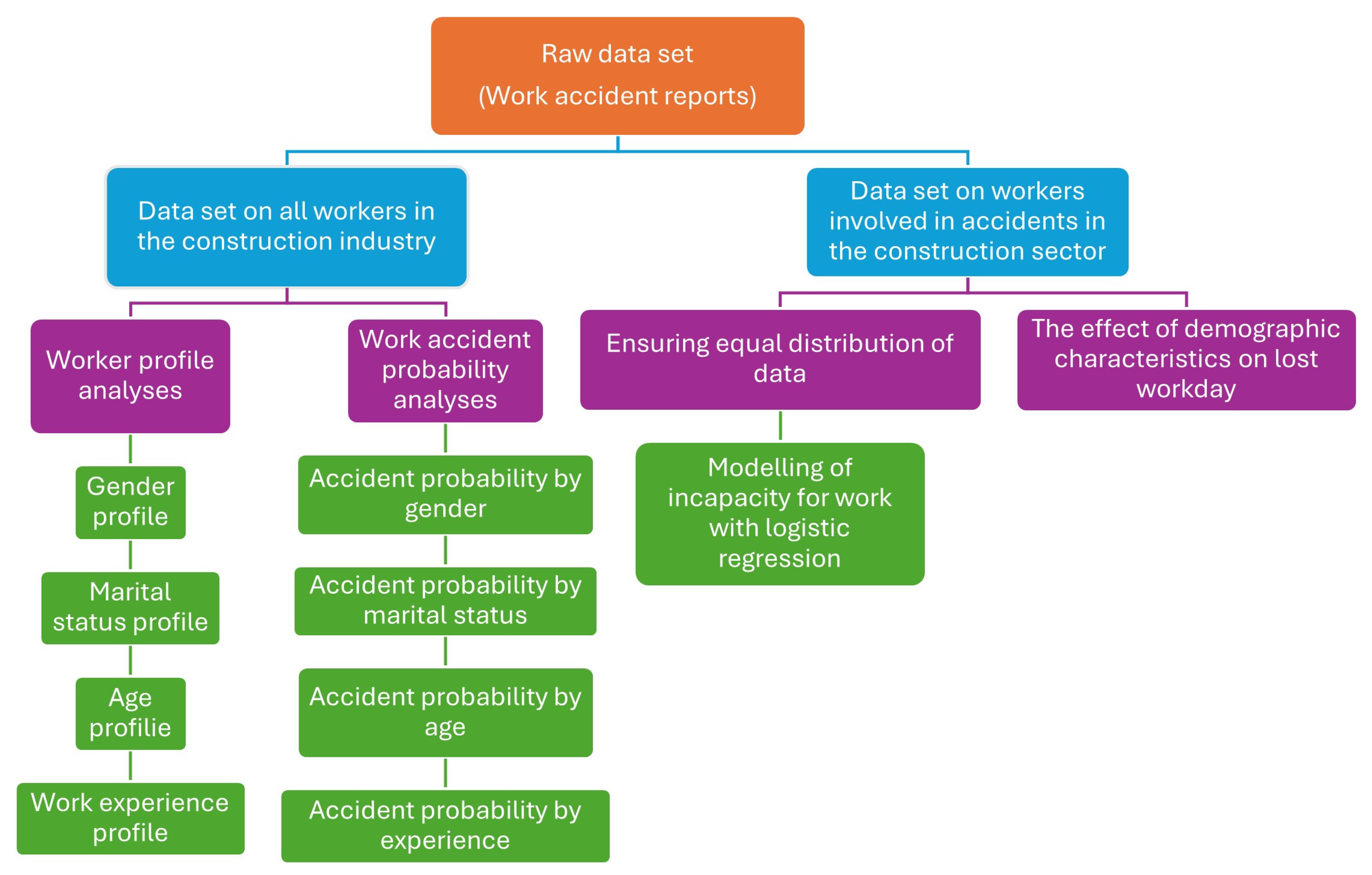

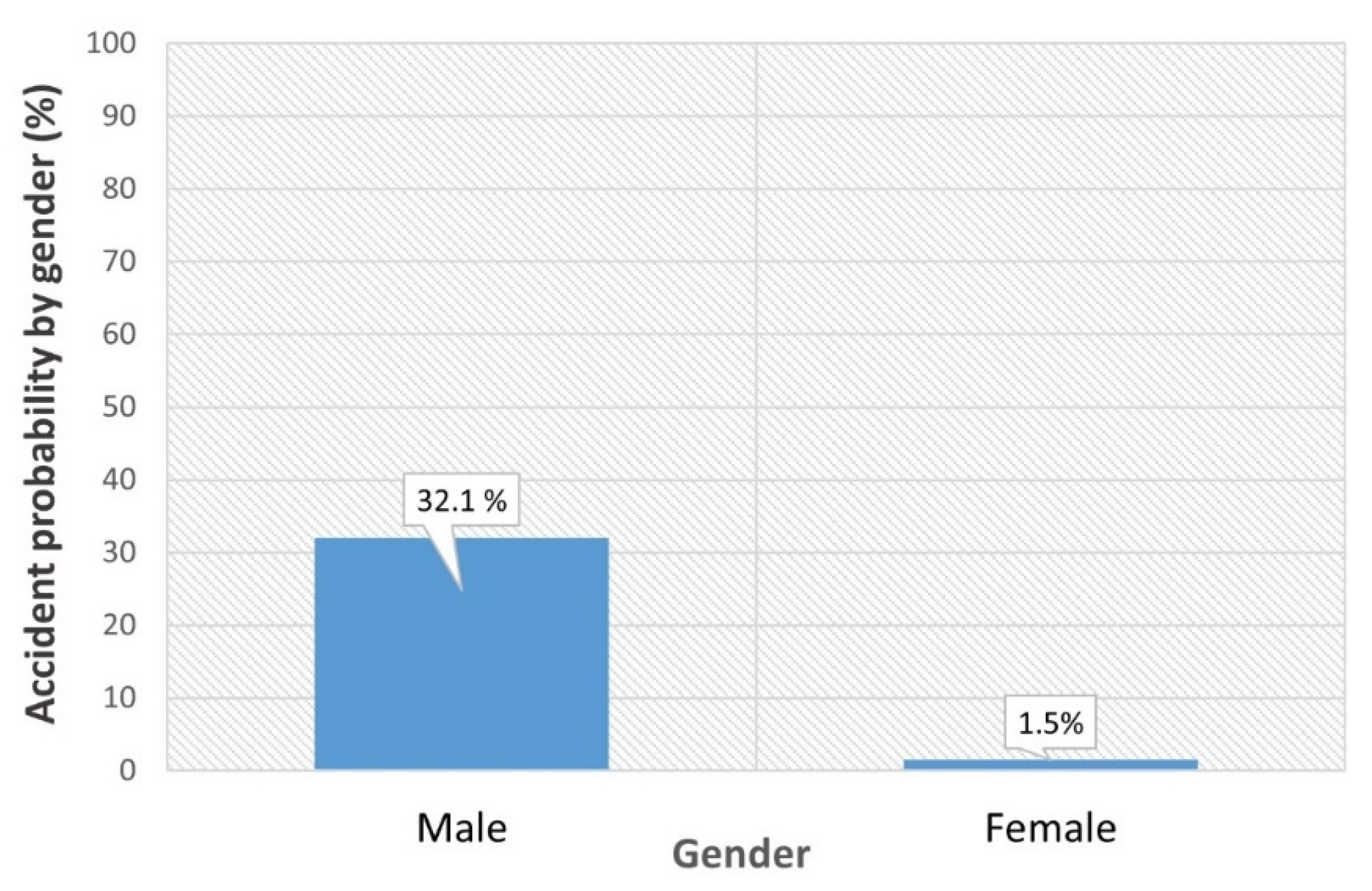

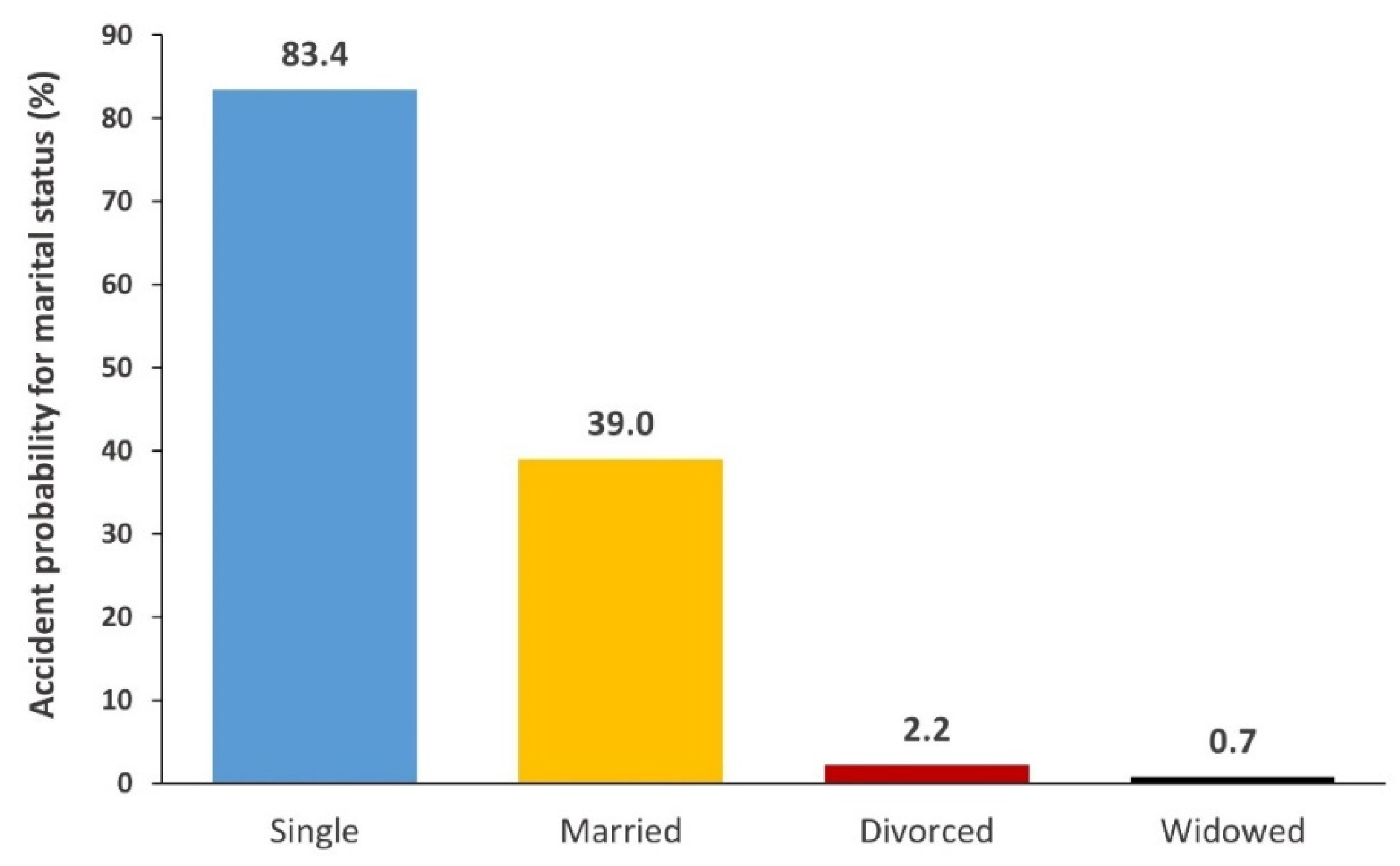

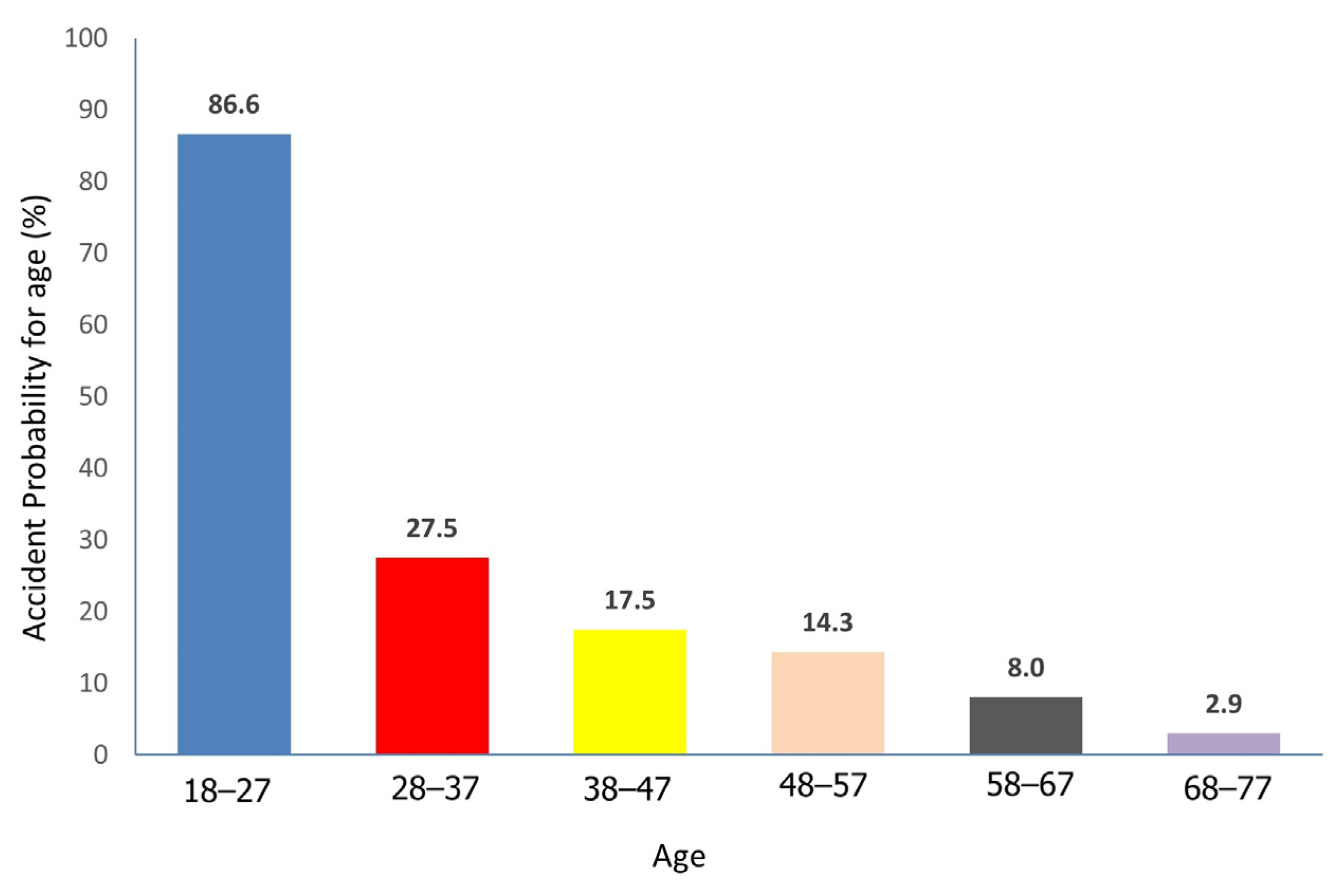
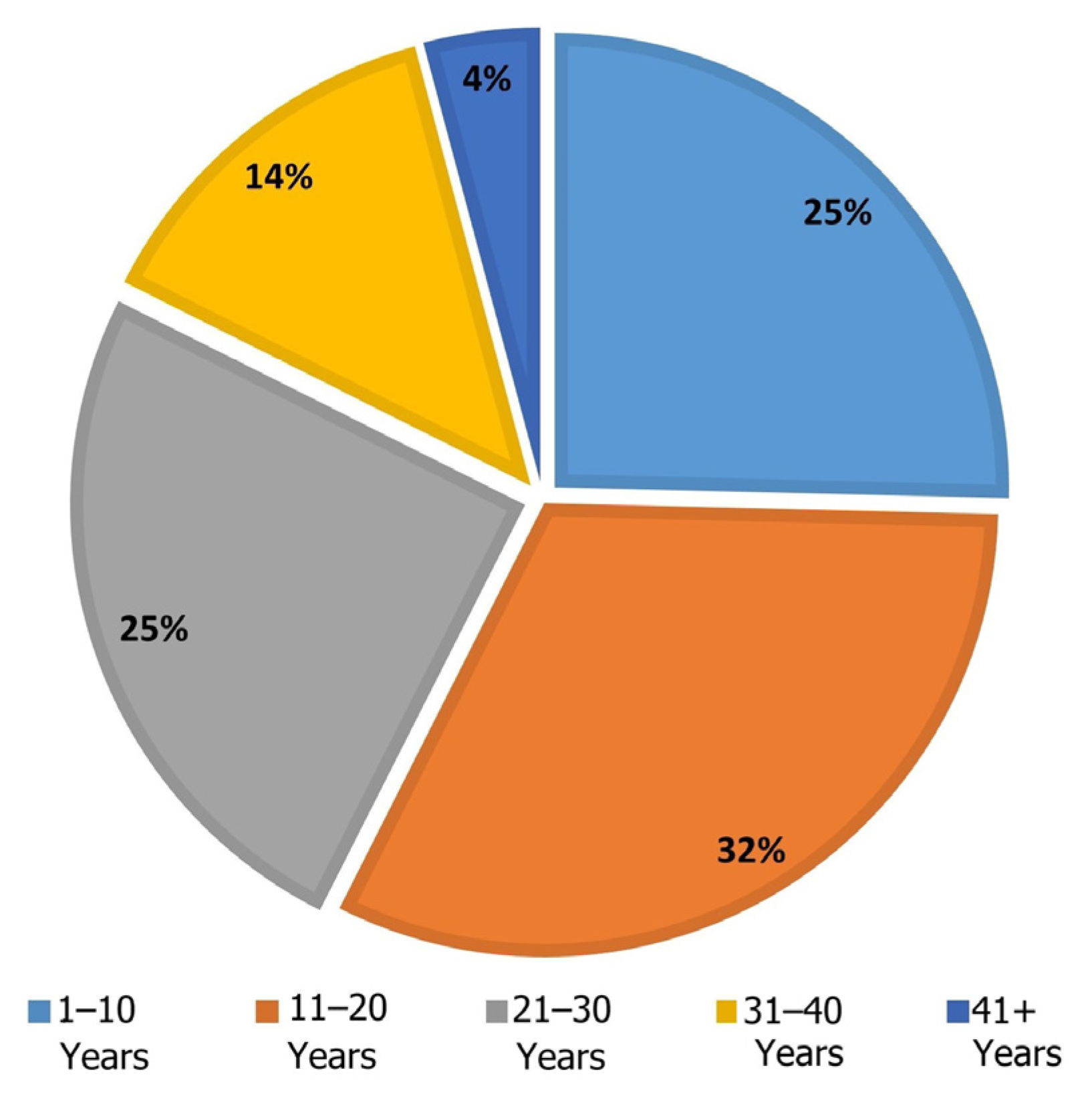
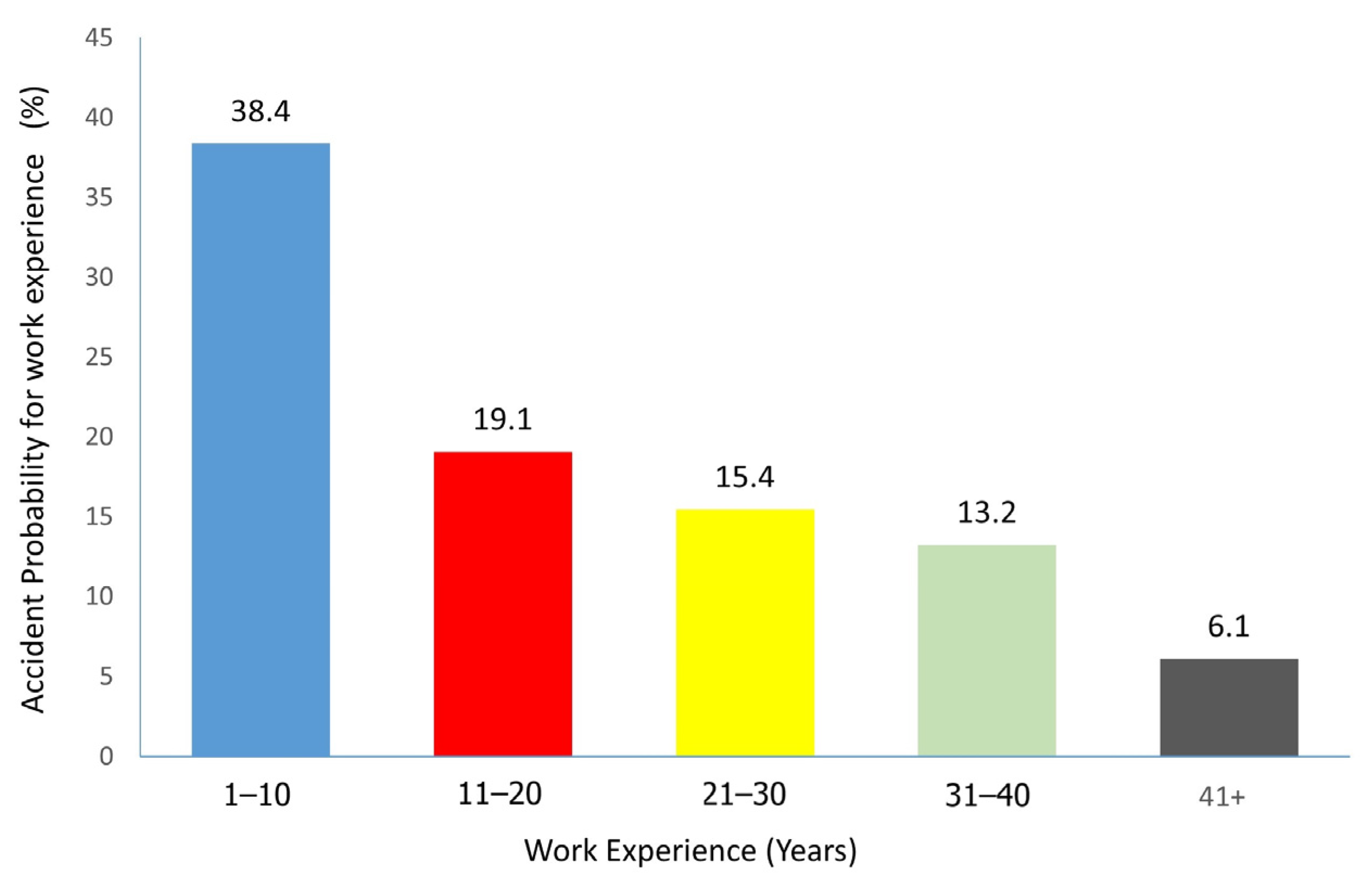


| Year | Workers | Occupational Injuries | Fatal Occupational Injuries | ||
|---|---|---|---|---|---|
| Numbers | Injury Rate * | Numbers | Fatality Rate ** | ||
| 2018 | 1,601,184 | 77,157 | 48 | 591 | 37 |
| 2019 | 1,294,788 | 47,701 | 37 | 368 | 28 |
| 2020 | 1,587,666 | 44,304 | 28 | 347 | 22 |
| 2021 | 1,630,678 | 58,107 | 36 | 386 | 24 |
| 2022 | 1,808,486 | 64,184 | 35 | 422 | 23 |
| Dependent Variable (Y) | Independent Variable (X) | Subcategory of Independent Variable | Frequency | Distribution of Subcategories (%) |
|---|---|---|---|---|
| Incapacity for Work | Age | 18–27 | 29,554 | 31.4 |
| 28–37 | 25,965 | 27.6 | ||
| 38–47 | 21,980 | 23.4 | ||
| 48–57 | 13,611 | 14.5 | ||
| 58 and above | 2898 | 3.1 | ||
| Experience | 0–5 year | 21,288 | 22.6 | |
| 6–10 year | 19,411 | 20.6 | ||
| 11–15 year | 16,351 | 17.4 | ||
| 16–20 year | 10,352 | 11.0 | ||
| 20 years above | 26,606 | 28.3 | ||
| Education status | Literate | 15,154 | 16.1 | |
| Primary school | 26,031 | 27.7 | ||
| Secondary school | 26,741 | 28.4 | ||
| High school | 20,807 | 22.1 | ||
| University | 5275 | 5.6 | ||
| Marital status | Single | 32,218 | 34.3 | |
| Divorced | 3435 | 3.7 | ||
| Widow | 231 | 0.2 | ||
| Married | 58,124 | 61.8 | ||
| Gender | Female | 1302 | 1.4 | |
| Male | 92,706 | 98.6 |
| B | S.E. | Wald | df | Sig. | Exp (B) | 95% C.I. for EXP (B) | |||
|---|---|---|---|---|---|---|---|---|---|
| Lower | Upper | ||||||||
| Step 1 a | Experience (0–5 year) | 163.871 | 4 | 0.000 | |||||
| Experience 1 (6–10 year) | 0.026 | 0.023 | 1.325 | 1 | 0.250 | 1.026 | 0.982 | 1.073 | |
| Experience 2 (11–15 year) | −0.133 | 0.030 | 19.604 | 1 | 0.000 | 0.875 | 0.825 | 0.928 | |
| Experience 3 (16–20 year) | −0.130 | 0.034 | 14.961 | 1 | 0.000 | 0.878 | 0.822 | 0.938 | |
| Experience 4 (20+ year) | −0.343 | 0.033 | 105.995 | 1 | 0.000 | 0.710 | 0.665 | 0.758 | |
| Marital status (Single) | 144.956 | 3 | 0.000 | ||||||
| Marital status 1 (Divorced) | −0.015 | 0.040 | 0.144 | 1 | 0.705 | 0.985 | 0.910 | 1.066 | |
| Marital status 2 (Widow) | 0.306 | 0.138 | 4.926 | 1 | 0.026 | 1.358 | 1.036 | 1.780 | |
| Marital status 3 (Married) | 0.218 | 0.021 | 111.032 | 1 | 0.000 | 1.243 | 1.194 | 1.294 | |
| Age (18–27) | 704.792 | 4 | 0.000 | ||||||
| Age 1 (28–37) | 0.453 | 0.026 | 298.438 | 1 | 0.000 | 1.574 | 1.495 | 1.657 | |
| Age 2 (38–47) | 0.782 | 0.032 | 587.525 | 1 | 0.000 | 2.186 | 2.052 | 2.328 | |
| Age 3 (48–57) | 0.932 | 0.037 | 651.514 | 1 | 0.000 | 2.539 | 2.364 | 2.727 | |
| Age 4 (58 and above) | 0.874 | 0.050 | 306.246 | 1 | 0.000 | 2.398 | 2.174 | 2.644 | |
| Education status (Literate) | 2661.633 | 4 | 0.000 | ||||||
| Education status 1 (Primary school) | 0.482 | 0.021 | 506.629 | 1 | 0.000 | 1.619 | 1.552 | 1.688 | |
| Education status 2 (Secondary school) | 0.640 | 0.021 | 904.907 | 1 | 0.000 | 1.896 | 1.818 | 1.977 | |
| Education status 3 (High school) | 0.977 | 0.022 | 1893.599 | 1 | 0.000 | 2.657 | 2.543 | 2.777 | |
| Education status 4 (University) | 1.419 | 0.035 | 1628.009 | 1 | 0.000 | 4.131 | 3.856 | 4.426 | |
| Gender 1 (Female) | −579 | 0.064 | 82.756 | 1 | 0.000 | 0.560 | 0.495 | 0.635 | |
| Constant | −517 | 0.067 | 60.353 | 1 | 0.000 | 0.596 | |||
Disclaimer/Publisher’s Note: The statements, opinions and data contained in all publications are solely those of the individual author(s) and contributor(s) and not of MDPI and/or the editor(s). MDPI and/or the editor(s) disclaim responsibility for any injury to people or property resulting from any ideas, methods, instructions or products referred to in the content. |
© 2025 by the author. Licensee MDPI, Basel, Switzerland. This article is an open access article distributed under the terms and conditions of the Creative Commons Attribution (CC BY) license (https://creativecommons.org/licenses/by/4.0/).
Share and Cite
Bilim, A. Demographic Analysis of Occupational Safety in the Construction Sector: Strategies and Insights for Risk Reduction. Buildings 2025, 15, 528. https://doi.org/10.3390/buildings15040528
Bilim A. Demographic Analysis of Occupational Safety in the Construction Sector: Strategies and Insights for Risk Reduction. Buildings. 2025; 15(4):528. https://doi.org/10.3390/buildings15040528
Chicago/Turabian StyleBilim, Atiye. 2025. "Demographic Analysis of Occupational Safety in the Construction Sector: Strategies and Insights for Risk Reduction" Buildings 15, no. 4: 528. https://doi.org/10.3390/buildings15040528
APA StyleBilim, A. (2025). Demographic Analysis of Occupational Safety in the Construction Sector: Strategies and Insights for Risk Reduction. Buildings, 15(4), 528. https://doi.org/10.3390/buildings15040528






